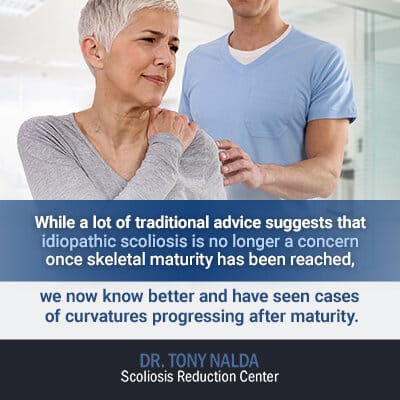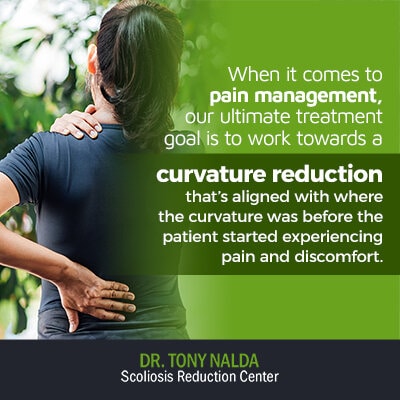Scoliosis can take many forms, and while it’s most commonly found in adolescents between the ages of 10 and 18, adults can develop the condition as well. When it comes to treating adults with scoliosis, treatment goals and approach can differ slightly as symptoms and progression are different once skeletal maturity has been reached.
To learn just how and why adult scoliosis differs from the condition’s most common form, adolescent idiopathic scoliosis (AIS), continue reading for a better understanding of adult scoliosis causes, symptoms, and progression.
Scoliosis and Age
As a progressive and incurable condition, living with scoliosis can pose challenges at any age. Scoliosis can be diagnosed in babies, juveniles, adolescents, and adults of any age.
Adolescents between the ages of 10 and 18 are the group with the highest rate of scoliosis development. Most often, when I examine an adult with scoliosis, they either had the condition during adolescence but didn’t start experiencing symptoms and get a diagnosis until adulthood, or it’s considered adult ‘de novo’ scoliosis. The latter represents the rarer form as it means there’s no history of living with the condition and has newly developed after skeletal maturity has been reached.
Regardless of whether or not a patient’s condition developed in adulthood or was carried with them from adolescence, the treatment approach can differ from how we treat our younger patients; that’s partially due to the causes of adult scoliosis. Understanding the causes leads to a better understanding of adult scoliosis in general.
Adult Scoliosis Causes
While some adult patients develop what we call ‘idiopathic’ scoliosis, meaning its cause is unknown, there are some known causes associated with adult scoliosis.
Sometimes, adults develop the condition because of bodily changes that occur after growth has stopped. It’s generally regarded that the aging process, plus degenerative changes to the body and spine over time, contribute to the development of degenerative scoliosis in older individuals. The age group most commonly affected by degenerative scoliosis is 40+.
Adult scoliosis can also develop as a secondary complication of other conditions and diseases.
Paralytic Curve
Other times, adult scoliosis can be caused by a ‘paralytic curve’, meaning the muscles closest to the spine aren’t working properly; this occurs after trauma to the spinal cord. When those muscles aren’t working properly, it can throw the spine off balance and out of alignment. This can lead to the development of an abnormal paralytic curvature that can progress over time.
Neuromuscular Scoliosis
Neuromuscular scoliosis can also develop in adults, and in these cases, the scoliosis develops as a secondary complication of a more serious disease such as muscular dystrophy, cerebral palsy, or polio.
In these instances, abnormal spinal curvatures are referred to as ‘myopathic’ deformities, meaning the spine’s surrounding muscles aren’t functioning properly.
Osteoporosis
Scoliosis in adults can also develop as a secondary condition caused by osteoporosis. The bone-mass loss that osteoporosis causes can lead to compression fractures of the spine that can result in scoliosis developing.
Adult Idiopathic Scoliosis
The aforementioned forms of adult scoliosis, with known causes, are far less common than the development of idiopathic curves in adults that are continuations of AIS progressing after maturity.
Cases of adult de novo scoliosis are less common as idiopathic scoliosis tends to develop in age groups facing a lot of growth. When a true case of de novo scoliosis develops in adults, other than degenerative changes, it can be difficult to know what’s caused its development; in these cases, it’s thought that a host of unique factors and their combination results in the condition development.

While a lot of traditional advice suggests that idiopathic scoliosis is no longer a concern once skeletal maturity has been reached, current research regarding adult scoliosis says the opposite: that adolescent curves still progress in adulthood.
Although we used to think of scoliosis as mainly an adolescent condition, current studies have shown that actual percentages of adults with scoliosis are higher than adolescents. Most common estimates put scoliosis in adolescents at 2 to 4 percent, while adults with the condition are estimated at 12 to 20 percent.
When women go through menopause in later life, this is connected with a loss of bone density, and those changes to bone health increase the likelihood of developing an abnormal spinal curvature. The common understanding is now that scoliosis rates increase with age, and that has shifted the thinking from scoliosis as largely an adolescent condition to one that affects all ages.
Treating Adolescents vs. Adults
The reason why there’s a marked difference in treating scoliosis in adults and treating scoliosis in adolescents is because related symptoms and patterns of progression vary significantly.
Adolescents
The big concern with treating adolescents and younger patients is that they’ve yet to reach skeletal maturity. In the context of scoliosis, we know that growth is the biggest trigger for progression. A huge part of our treatment approach with younger patients is to constantly monitor them for growth and how as little as an inch of growth can affect their curvature.
The other big difference is in terms of scoliosis-related pain and discomfort. With my younger patients, pain management isn’t a big concern as while growth is still occuring, the compressive forces of scoliosis are a nonissue; this is because the spine is experiencing a constant lengthening motion throughout growth.
In treating adolescents and younger patients, the big treatment focus is always to first address the structural issue of the curvature, and we do this by constantly tweaking our treatment plan to stay ahead of patterns of progression.
The ultimate treatment goal is to achieve a reduction in the curvature. This is accomplished through a customized treatment plan including chiropractic adjustments, scoliosis-specific therapy, exercises, stretches, and custom 3-D bracing when necessary. Any and all of these treatment approaches can be used with adults as well.
Adults
When it comes to adults with the condition, pain is most often the symptom that brings them into the Scoliosis Reduction Center® for a diagnosis. In most cases of adult idiopathic scoliosis that are continuations of AIS, this is because when the patients were younger, they didn’t experience pain and were unaware they had the condition; it’s not until growth has stopped that the compressive forces of the scoliosis are felt in the spine, its surrounding muscles, tissues and nerves.
Pain Management
While the primary treatment goal is the same when treating patients of different ages – addressing the structural issue of the curvature – with adults, pain is a very real symptom that needs to be addressed. While pain medication has its place, I don’t like to overly rely on it because it can hide characteristics of the condition that we need to be aware of. For example, if a patient is highly medicated for pain, their condition could be progressing without them knowing as they can’t feel what their body is trying to tell them.
With adult scoliosis, often their pain isn’t felt in the back, but in other areas of the body such as the neck, legs, and feet; this is a result of the compression of spinal nerves causing radiating pain throughout the body.
Our first choice, in terms of pain management for adults with scoliosis, is to address the underlying condition; if we do that and treat it accordingly, the structural issue causing the pain is corrected, removing or lessening related symptoms such as pain and discomfort. This is not only a less invasive and more natural approach to pain management, it also means preserving the spine’s natural strength, flexibility, and overall function.

When it comes to pain management, our ultimate treatment goal is to work towards a curvature reduction that’s aligned with where the curvature was before the patient started experiencing pain and discomfort. If we can get their spine to correct back to where it was before they started really experiencing noticeable symptoms, treatment efforts then shift to maintaining that reduction and comfort level.
Although we know that progression can continue in adulthood, rates tend to be slower as that natural trigger of growth has been removed. In this respect, we don’t have to monitor quite as closely as we do in ages where growth is still happening.
Conclusion
When it comes to treating scoliosis in adults, the underlying treatment goal is the same as when treating younger patients: to achieve a curvature reduction. That being said, there are different aspects of treatment that reflect the different characteristics of adult and adolescent scoliosis.
The biggest difference is in terms of progression. Adolescents and young children face the biggest risk of rapid progression because they have yet to go through significant and unpredictable growth spurts. In adulthood, those rapid growth patterns are no longer an issue, although adult scoliosis can progress, just generally at slower rates.
In this regard, closely monitoring a patient for growth and related progression is not such a priority in our older patients as it is with our younger ones. When it comes to scoliosis-related pain, this is another big difference between the two forms of the condition.
In AIS patients, it’s quite uncommon to have to address and treat pain; in adults, pain and discomfort is the symptom that most commonly brings them in for a diagnosis. In most of these cases, their scoliosis has been progressing for years, but when it occurred during growth, they couldn’t feel it.
The more severe scoliosis is, the more likely it is to produce noticeable changes to the body, and this can be said in all forms of the condition. Ranging from mild, moderate, and severe, adult scoliosis can present with a number of different symptoms.
Although patients who start treatment while the condition’s in its earlier stages are more likely to have successful results, it’s never too late to start treatment. Here at the Scoliosis Reduction Center®, we’ve treated patients of all ages and all forms of the condition.
If you’re an adult living with scoliosis, there are a number of effective and sustainable treatment approaches we can offer to help manage your pain and achieve a functional curvature reduction.





